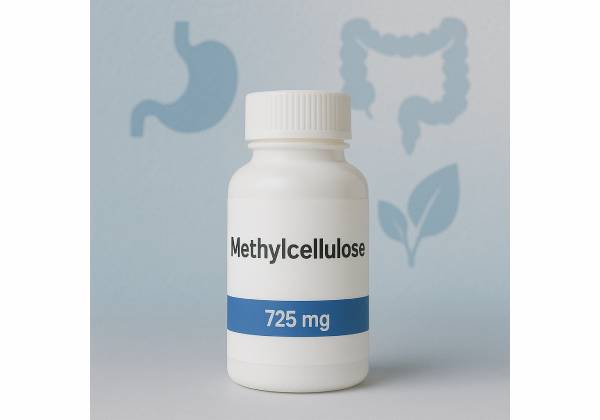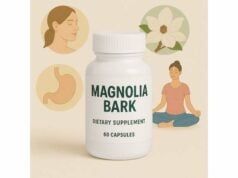
Methylcellulose is a purified, plant-derived soluble fiber used worldwide as a gentle, bulk-forming laxative and as a versatile food and pharmaceutical thickener. In the gut, it binds water, increases stool bulk, and softens stool consistency—two actions that help restore comfortable, regular bowel movements without stimulant effects. Unlike many fermentable fibers, methylcellulose is largely non-fermentable, so it’s less likely to cause excess gas for people sensitive to bloating. Beyond constipation relief, clinicians use it to improve stool form in loose stools, support bowel regularity during pregnancy, and as part of care plans for irritable bowel syndrome (IBS) when a well-tolerated fiber is needed. It mixes easily in cold water, is gluten-free, and is available as flavored powders and 500 mg caplets. Still, results depend on proper dosing and fluid intake, and it isn’t right for everyone—especially those with swallowing difficulties or bowel obstruction. Below you’ll find a practical, evidence-aware guide to how methylcellulose works, who it helps most, how to take it correctly, dosing ranges that clinicians use, and safety steps to keep it comfortable and effective.
Quick Overview
- Eases constipation by increasing water content and bulk of stool; generally works in 12–72 hours.
- Often better tolerated than fermentable fibers; tends to cause less gas and bloating.
- Typical adult dose: 1 heaping tablespoon powder (≈2 g) in 240 mL water up to 3 times daily, or 2 × 500 mg caplets with 240 mL water up to 6 times daily (max 12 caplets/day).
- Always take with at least 240 mL (8 oz) of fluid; separate from other oral medicines by about 2 hours.
- Avoid if you have swallowing difficulties, bowel obstruction/impaction, or unexplained abdominal pain; seek medical advice first.
Table of Contents
- What is methylcellulose and how does it work?
- Who benefits most and practical use cases
- How to take methylcellulose (step-by-step)
- Dosage, timing, and how long to use it
- Common mistakes and troubleshooting
- Safety, side effects, and who should avoid it
- Evidence at a glance: what studies and guidelines say
What is methylcellulose and how does it work?
Methylcellulose is a chemically modified cellulose (a natural plant polymer) where a portion of the hydroxyl groups are replaced with methoxy groups. That change makes it water-soluble and gives it two properties that explain its gastrointestinal benefits:
- Water binding and gel formation. When mixed with cold water, methylcellulose disperses and forms a smooth, viscous solution. In the intestine, the hydrated fiber increases the water content and volume of stool (bulk-forming effect) and creates a soft gel matrix around stool particles. This dual action stimulates normal peristalsis and makes stools easier and more comfortable to pass.
- Minimal fermentation. Many soluble fibers (for example, inulin) are fermented by colonic bacteria into gases and short-chain fatty acids. Methylcellulose is unusual: despite being soluble, it is largely non-fermentable in humans. For people who experience bloating or gas with fermentable fibers, this property often translates into better day-to-day tolerance.
A second, practical advantage is mixability. Methylcellulose dissolves best in cold water and doesn’t thicken instantly into clumps the way some fibers do, which makes compliance easier. Because it is synthetic from purified plant cellulose (not a grain protein), it’s gluten-free and non-allergenic, and commercial products are available as flavored powders and 500 mg caplets.
Clinically, methylcellulose is classified as a bulk-forming laxative. It does not stimulate the bowel directly, so effects are gradual (typically within 12–72 hours) and gentle. That makes it suitable for regularity support in many settings, including pregnancy, older adults, and individuals with sensitive guts—provided it’s taken with adequate fluids and the total dose is built up patiently over several days.
Finally, methylcellulose also appears in foods and pharmacy formulations as a thickener (E461) and stabilizer. Those roles are outside the scope of therapeutic dosing, but they highlight its broad safety record and explain why you may see it listed on ingredient panels.
Who benefits most and practical use cases
Occasional or chronic constipation. The most established use is relieving infrequent bowel movements and hard stools. By increasing stool bulk and softness together, methylcellulose reduces straining and discomfort—often a good first-line option before stimulant laxatives. Its non-stimulant, gradual effect is valuable for people who want to avoid urgency or cramps.
Constipation with gas sensitivity. If fermentable fibers (like inulin or certain wheat bran products) trigger bloating, a non-fermentable option may be more comfortable. Many people with gas-prone guts tolerate methylcellulose better because it does not appreciably increase colonic gas.
Loose stools with poor form. Not every fiber is only for constipation. A viscous, non-fermentable fiber can normalize stool consistency from either direction. For individuals with frequent but poorly formed stools (for example, some with IBS-D, post-cholecystectomy, or after mild gastroenteritis), a modest dose of methylcellulose may improve stool form by absorbing excess water and adding structure. Clinicians also use it in selected cases of fecal urgency or incontinence to increase stool cohesiveness.
IBS where fiber is recommended but poorly tolerated. Guidelines commonly suggest soluble fiber for IBS, with the caveat that patient tolerance varies. When psyllium or other fibers cause gas, methylcellulose is a reasonable alternative to trial—especially in IBS-C or mixed patterns—because it is less likely to ferment.
Pregnancy-related constipation. Since bulk-forming fibers are not systemically absorbed, they are considered suitable during pregnancy when diet and fluids aren’t enough. Methylcellulose can be a gentle bridge while lifestyle measures take effect, provided choking warnings are respected and doses are taken with plenty of water.
Older adults and people on constipating medicines. Many older adults or those taking constipating medications (for example, some opioids, iron, or anticholinergics) need ongoing stool-softening support. A scheduled methylcellulose routine—paired with fluids—can reduce straining and maintain regularity.
Dietary preferences. For those who avoid grain-derived ingredients or desire a gluten-free fiber, methylcellulose fits easily into diverse diets. Flavored (sucrose-containing) and sugar-free powders give options for people who need to limit added sugars.
A few nuances: non-fermentable fiber won’t deliver the same microbiota-mediated effects as fermentable fibers. If your goal is to increase short-chain fatty acid production for colonic health, you may pair a small dose of fermentable fiber once bloating is under control. Methylcellulose is about comfortably normalizing stool mechanics—and for many, that’s exactly what’s needed to feel better day to day.
How to take methylcellulose (step-by-step)
1) Pick a form that fits your routine.
- Powder for solution (orange or sugar-free): mixes into cold water; one “heaping” or “rounded” tablespoon per dose depending on product.
- Caplets (500 mg each): portable, tasteless option; dose in multiples of two caplets.
2) Measure and mix correctly.
- Powder: Fill a glass with at least 240 mL (8 oz) of cold water, add the measured dose, stir briskly, and drink promptly. Follow with another half-glass of water if you like.
- Caplets: Swallow 2 caplets with at least 240 mL (8 oz) of water. Do not chew or crush.
3) Time your doses.
- For regularity, take once daily at the same time for 2–3 days, then titrate (increase) slowly to 2–3 times daily if needed.
- Avoid taking immediately before bedtime to reduce the risk of throat irritation or choking while lying down.
4) Separate from other oral medications.
Bulk-forming fibers can reduce or delay absorption of other drugs. A practical rule is to take other oral medicines at least 2 hours before or 2 hours after methylcellulose.
5) Hydration is non-negotiable.
The single most important success factor is water. Every dose must be taken with a full glass of fluid. Low fluid intake can cause the powder to thicken before it reaches the stomach or may worsen constipation downstream.
6) Build gradually and assess.
- Start low for 2–3 days, then increase by one dose as needed.
- Track stool frequency and form (for example, using the Bristol Stool Chart). The sweet spot is a soft, formed stool (Type 3–4) most days without straining.
7) Pair with routine basics.
Continue dietary fiber from foods, regular movement, and consistent fluid intake. If you add fermentable fibers later for microbiome goals, start with very small amounts and increase only if gas remains comfortable.
8) When to add or switch therapies.
If stools remain hard after a week at your target methylcellulose dose, clinicians often add an osmotic agent (for example, polyethylene glycol) as a complementary approach. If stool is soft but difficult to pass, a short course of a stimulant laxative may be layered in cautiously and then cycled off.
9) Storage and handling.
Keep containers tightly closed and dry; use within the product’s recommended timeframe. Sugar-free flavored powders may contain aspartame (phenylalanine)—people with phenylketonuria must check labels carefully.
Done consistently, these steps prevent the most common problems: clumping, inadequate fluids, conflicts with medication timing, and “too much too soon” escalation.
Dosage, timing, and how long to use it
Typical adult dosing (≥12 years).
- Powder for solution: Most branded labels specify 1 heaping or rounded tablespoon (≈2 g methylcellulose) in at least 240 mL (8 oz) cold water up to 3 times daily. Start with 1 dose daily; titrate to effect.
- Caplets (500 mg each): 2 caplets with at least 240 mL water up to 6 times daily; do not exceed 12 caplets/day. Practical starting plan: 2 caplets once daily; increase by one dose every 48–72 hours based on response.
Children.
Labels commonly state 6–11 years may start at half the adult dose (for powders, about 2.5 level teaspoons), up to 3 times daily. Under 6 years: consult a clinician before use. Pediatric stooling problems warrant individualized guidance.
Older adults.
Begin at the low end (one powder dose or 2 caplets daily) and titrate slowly. Adequate hydration and medication spacing are especially important to avoid interactions.
Pregnancy and lactation.
Bulk-forming fibers are not systemically absorbed and are commonly used for pregnancy-related constipation when diet and fluids aren’t enough. As with everyone, ensure each dose is taken with a full glass of water; avoid if swallowing is difficult. If symptoms persist, review with a clinician rather than escalating indefinitely.
Loose stools/urgency.
For stool-forming support (e.g., frequent unformed stools), a single daily dose is often enough. Increase to twice daily if needed, monitoring for firmness. If stools become too firm, reduce by one dose.
When to expect results.
Bulk-forming laxatives generally work within 12–72 hours. Many people notice smoother, more regular stools by day 2–3 at a stable dose.
How long can you use methylcellulose?
It is often used intermittently for short spells (several days to a few weeks). For chronic tendencies, some people maintain a steady, lowest-effective dose long-term alongside diet and activity. If you need escalating doses or have persistent symptoms beyond 7 days, or you experience rectal bleeding or unexplained abdominal pain, seek medical evaluation rather than continuing to up-titrate.
Practical sample plans.
- Constipation prone: Day 1–3: 1 powder dose (2 g) with breakfast. Day 4–6: add a second dose mid-afternoon. If needed, Day 7+: add a third dose.
- IBS with variable stools: Start with 1 caplet dose (2 × 500 mg) daily for a week. If stools remain loose, increase to twice daily; if stools become too firm, step back.
Special product notes.
Flavored powders may contain sucrose (calories) while sugar-free versions use aspartame; check labels if you monitor sugars or have phenylketonuria. Caplets are convenient for travel but must still be taken with a full 240 mL of water.
Common mistakes and troubleshooting
Taking it with too little water.
This is the most common—and riskiest—error. Every dose must be taken with at least 240 mL (8 oz) of fluid. Insufficient water increases the chance of throat/esophageal swelling or choking and can worsen constipation downstream. If you struggle to drink a full glass, split the glass: half before mixing and half right after.
Jumping to a high dose too fast.
If you take multiple doses on day one, you may feel too full or notice sluggishness. Start with one daily dose for 2–3 days, then increase gradually.
Clumping powder in warm water.
Methylcellulose disperses best in cold water. Add powder to the water (not the other way around), stir briskly, and drink promptly before it thickens.
Taking it too close to medications.
Bulk fiber can bind or delay other oral drugs. Keep a 2-hour buffer before or after prescription and OTC medicines, including vitamins and minerals. If you take multiple daily meds, schedule methylcellulose between your usual medication times (for example, midday and late afternoon).
Expecting instant results.
Bulk-forming fiber is gentle and can take 12–72 hours to normalize bowel movements. If you need rapid relief from uncomfortable constipation, your clinician may suggest adding an osmotic laxative short term while methylcellulose builds effect.
Over-firm stools after success.
If your stool becomes too firm or less frequent after initially improving, step down by one dose or increase your daily fluids. Some people do best with a single morning dose only.
Gas or upper GI fullness.
Though methylcellulose is non-fermentable, a sense of fullness can occur if you increase too quickly. Drop back to the prior dose for 3–4 days, then try again. If gas persists, review your diet for fermentable carbohydrate triggers (onion/garlic/inulin) and adjust.
Relying on fiber alone when other issues are present.
Iron supplements, opioids, and certain anticholinergics can override fiber’s benefits. If you take constipating medicines, ask your clinician about a combination plan (fiber plus an osmotic agent, stool softener, or per-medication strategies).
Ignoring red flags.
Rectal bleeding, persistent constipation beyond a week of correct use, unexplained abdominal pain, nausea/vomiting, or sudden changes in bowel habits lasting >2 weeks warrant medical evaluation, not continued self-titration.
Travel and routine disruption tips.
Caplets pack well; keep a refillable bottle to guarantee you have at least 240 mL water per dose. For powders, measure single servings into small containers so you can mix quickly in cold water on the go.
Safety, side effects, and who should avoid it
Typical side effects (usually mild and temporary):
- Sensation of fullness or early satiety when starting or increasing the dose.
- Mild bloating; generally less gas than fermentable fibers.
- Changes in stool form while you titrate (firmer or softer before stabilizing).
Serious but uncommon risks (seek care):
- Choking or esophageal blockage if taken without enough water or in people with swallowing difficulties. Symptoms include chest pain, difficulty swallowing or breathing, or vomiting shortly after dosing.
- Bowel obstruction or impaction if used in the presence of intestinal blockage or severe, long-standing constipation without evaluation.
- Allergic reactions are rare with methylcellulose itself; flavored products contain other ingredients (colorants, flavorings) that can rarely cause reactions.
Do not use unless a clinician approves if you have:
- Trouble swallowing, esophageal strictures, or known motility disorders affecting the esophagus.
- Known or suspected bowel obstruction, fecal impaction, or unexplained abdominal pain, nausea, or vomiting.
- A sudden change in bowel habits that persists more than two weeks.
- Phenylketonuria (PKU) if you intend to use aspartame-sweetened sugar-free powders (they contain phenylalanine).
- Children under 6 years of age (specialist guidance required).
Drug and nutrient interactions:
- Space other oral medicines 2 hours before or after methylcellulose to avoid binding or delayed absorption. This includes common prescriptions, over-the-counter drugs, and mineral supplements (iron, calcium).
- If you rely on medications with narrow therapeutic windows, ask your pharmacist to help schedule dosing.
Pregnancy and breastfeeding:
- Bulk-forming fibers like methylcellulose are commonly used during pregnancy because they are not absorbed and have not been linked with pregnancy complications when used as directed. The same hydration and choking warnings apply. During breastfeeding, they are considered compatible.
Diabetes and calorie considerations:
- Flavored powders may contain sucrose and contribute small calories; sugar-free versions are available. Caplets typically contain negligible sugars.
When to stop and reassess:
- If constipation lasts longer than 7 days of correct use, if you develop rectal bleeding, or if you fail to have a bowel movement after use—stop and consult a clinician. These may signal a condition requiring a different approach.
With correct preparation, adequate fluids, and sensible titration, methylcellulose is among the most well-tolerated fiber options for normalizing stool mechanics in everyday life.
Evidence at a glance: what studies and guidelines say
Guideline support for fiber in chronic constipation. Leading gastroenterology societies recommend fiber therapy—particularly soluble fiber—as part of first-line management for chronic idiopathic constipation. Bulk-forming agents like methylcellulose are positioned for their stool-softening, bulking, and safety profile. Clinical guidance emphasizes gradual dose increases and hydration, and it recognizes that some individuals need an adjunctive osmotic agent if stool remains hard.
Non-fermentable tolerance advantage. Controlled human studies and in-vitro work indicate methylcellulose is minimally fermented by colonic microbiota compared with fermentable fibers. In practice, that often means less gas and better day-to-day comfort for gas-sensitive people, including many with IBS. This mechanistic difference explains why some patients who cannot tolerate inulin or certain brans do well when switched to methylcellulose.
Constipation outcomes. Large pragmatic cohorts and clinical experience show improvements in stool frequency, ease of passage, and consistency with one to three tablespoons per day, often normalizing bowel habits over several weeks. While many modern randomized trials focus on psyllium, real-world data and smaller trials support methylcellulose as an effective bulk-forming option—especially when the clinical goal is comfortable, predictable stools rather than microbiota modulation.
Stool form in loose stools and urgency. By absorbing water and increasing viscosity, methylcellulose can improve stool cohesion in selected patients with fecal urgency or incontinence and in IBS subgroups with loose stools. In these scenarios, modest, once-daily dosing is usually sufficient; overtreatment can firm stools excessively.
Pregnancy safety. Independent medication-in-pregnancy resources and national health services consider bulk-forming fibers, including methylcellulose, acceptable during pregnancy when diet and fluids aren’t enough—reflecting their lack of systemic absorption and long safety history. As always, persistent symptoms warrant clinician oversight.
Bottom line. Methylcellulose is a people-first fiber: easy to mix, gentle, and less gassy than many alternatives. It excels at normalizing stool mechanics in both constipation and certain loose-stool patterns, provided dosing is built up patiently and paired with fluids. For microbiome-targeted goals, fermentable fibers may be layered later if tolerated; for comfort-first regularity, methylcellulose alone is often exactly right.
References
- American Gastroenterological Association-American College of Gastroenterology Clinical Practice Guideline: Pharmacological Management of Chronic Idiopathic Constipation – PubMed 2023 (Guideline)
- DailyMed – CITRUCEL- methylcellulose powder, for solution 2024 (Label)
- The relation of passage of gas an abdominal bloating to the production of gas in the colon – PubMed 1996 (RCT)
- Management of irritable bowel syndrome in primary care: the results of an exploratory randomised controlled trial of mebeverine, methylcellulose, placebo and a self-management website – PubMed 2013 (RCT)
- Treating constipation during pregnancy 2022 (Guidance)
Disclaimer
This guide is educational and does not replace personalized medical advice. Always consult a qualified healthcare professional for diagnosis and treatment, especially if you have ongoing symptoms, chronic conditions, are pregnant or breastfeeding, take prescription medicines, or have red-flag signs like rectal bleeding, weight loss, fever, or severe abdominal pain. Never ignore professional advice because of something you’ve read here.
If you found this article helpful, consider sharing it with a friend or on Facebook or X to support our work. You’re also welcome to follow us on your preferred social platform for future evidence-based guides.










